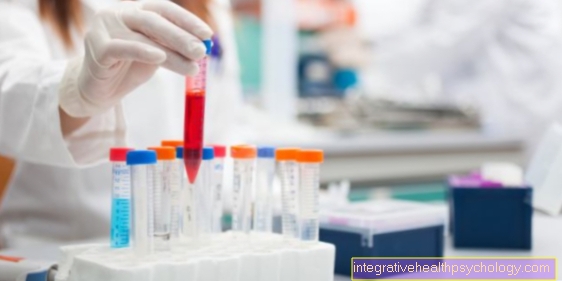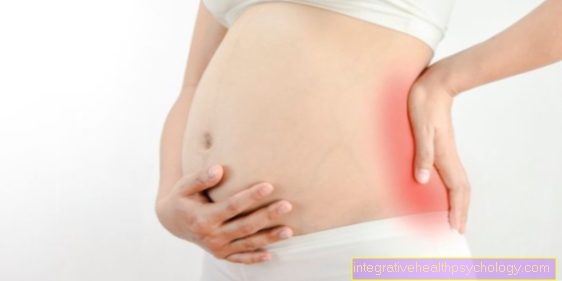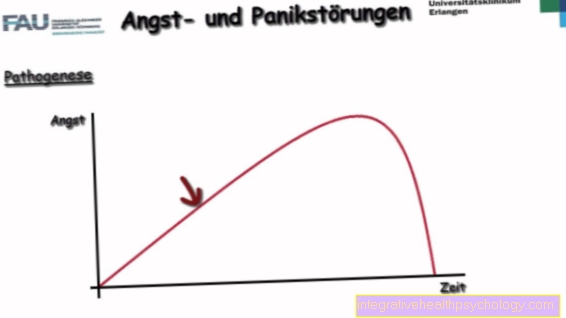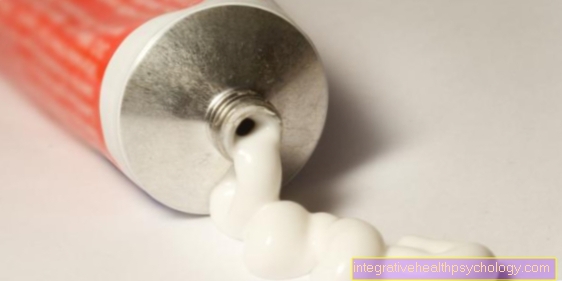lymph
definition
The lymph (lat. Lympha = clear water) is an aqueous, light yellow liquid that is located in the lymph vessels. The lymph is tissue fluid pressed out of the blood vessels. The many individual lymph vessels and lymph nodes are collectively referred to as the lymph system and are the most important transport system in the human body alongside the blood circulation. Its main purpose is to transport nutrients and waste. In addition, the cells in the lymph nodes in particular serve to defend against bacteria and other foreign bodies.
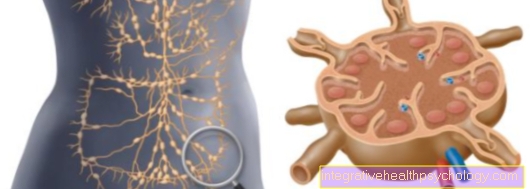
Properties of the lymph
The lymph is composed similarly to the tissue fluid: It consists of Cells and the Lymph plasma.
It also contains urea, creatinine, glucose, potassium, sodium, phosphate and calcium. Numerous enzymes are also part of the lymphatic fluid; likewise the substances involved in coagulation Fibrinogen and Fibrin precursors.
The concentration of Egg whites in the lymph is about 2 grams per liter. In the lymph vessels of the Digestive tract this concentration can increase up to 4g / liter in the Vessels of the liver even up to 6 g / liter. Because of the mixing, the average protein content is 3-5g / liter.
The composition of the lymph can also change after high-fat meals: it then contains 1-2 g / liter of lipids (fats). As a result, the lymph looks rather milky and then becomes as Chyle designated. Of the PH value the lymph is 7.41, its density 1.14 g / cm3.
Formation of the lymph
Part of the blood plasma flows out of the smallest blood vessels due to a pressure gradient (Capillaries) into the surrounding tissue and nourishes it. At the same time, this process serves that Removal of metabolic end products.
Since the cells of the blood cannot penetrate the vessel walls, this tissue fluid consists only of Water and solutes. About 90% of the tissue fluid then gets back into the blood vessels with the substances intended for removal and is kidney eliminated.
The remaining liquid is called lymph designated. It collects in the lymphatic system and is then transported away. In humans will per day approx. 2-3 liters of lymph educated.
Lymphatic drainage areas
Lymph drainage of the face
The lymph of the face is directed through fine lymph vessels neck transports and contains tissue fluid and waste products of cell metabolism in the facial area. If there is an obstruction to drainage, it can Swelling of the face come.
The manual Lymphatic drainage an experienced physiotherapist will be very effective. Additionally can Skin defects lead to activation of the lymphatic system, which also results in a swelling of the local Lymph nodes can go hand in hand. These are for example on the neck, in the neck and on Lower jaw below the chin.
Read more on the topic: Lymph node swelling in the lower jaw and Lymph node swelling in the neck - dangerous?
Lymph drainage of the eyes
The fine Lymphatic drainage system of the eye absorbs the fluid between tissue and blood vessels and transports it towards the neck in larger lymph vessels. Swelling around the eyes, for example one Eyelid swelling, indicate a disturbed outflow of the lymph and can be targeted by massage in the area of the face can be facilitated by experienced physiotherapists.
Read more on the topic: Swelling of the eyes
Lymph drainage of the ear
The lymph drainage of the Ear flows into the larger ones Lymphatics of the neck a. First minor Lymph nodes are in the immediate vicinity in front of and behind the auricle. If inflammation occurs in the area of the outer ear, it comes to swelling this lymph node. Inflammation in the inner part of the ear drains into deeper lymph node stations.
Lymph drainage on the neck
The lymph vessels in the neck are a special feature in the human body. Basically, lymph flows from superficial channels in the direction of deeper lymph vessels. The connection between the superficial and deep lymphatic systems is particularly pronounced on the neck as well as in the armpit and groin region. The connection points have numerous lymph nodes, which effectively filter potential pathogens before they can penetrate the deeper system.
In the case of infections in the neck region, such as tonsillitis or a cold, the local lymph nodes on the neck swell, which can then be palpated from the outside. When the infection subsides, the swelling also goes down.
Read more on the topic: Lymph node swelling on the neck - dangerous?
From an anatomical point of view, lymph nodes are always located in the catchment area of a specific organ and are often also involved in cancer. If cancer occurs in the neck area, the lymph nodes must also be sufficiently removed in addition to the cancer focus; this is ensured by a so-called "neck dissection".
Breast lymph drainage
The lymph of the chest is closely interconnected with the lymphatic drainage of the Armpit. In the case of diseases of the breast, it quickly comes to swelling the lymph nodes in the armpit. Corresponding diseases of the breast include both Inflammation of the chest, at Breast lump but also canker sores.
For example, as part of the Breast cancer therapy If the armpit lymph nodes are also removed, there are a few things to consider. Clothing that is too tight should be avoided in order to avoid constrictions and thus congestion of the tissue fluid. Blood pressure measurements on the arm on the affected side should be avoided, as should blood samples. These measures bend you down Lymphedema of the arm in front.
Read more on the topic: Breast cancer
Lymph drainage of the legs
The lymph of the legs runs strictly along the vascular system in close proximity to the muscles. Thus, your flow is particularly well stimulated by muscle activity. The muscles of the legs tense when walking, the lymph in the lymphatic vessel is pressed towards the head and lymph vessel valves prevent reflux. The lymph of the legs flows in the Groin region through closely interconnected Lymph node stations.
At Infections In the leg region such as infected wounds, these lymph nodes filter out pathogens and swell. They are now very palpable and represent a clinical course parameter for the inflammatory activity. Lymphedema in the legs are particularly impressive, as here an increase in circumference and size is often noticeable first.
Read more on the topic: Lymph node swelling in the groin - dangerous?
Function of the lymph
The lymphatic system primarily serves that Transport of larger materialswhich cannot get back into the blood vessels through the capillary wall. These include in particular Fats (Lipids) and Egg whites (Proteins).
For another, the lymphatic system is an important part of the Immune defense. It transports Foreign bodies and germs to the lymph nodes. The immune defense is then initiated in these by the corresponding defense cells (Lymphocytes) multiply through the presentation of the foreign body and antibody against form.
The multiplication of these specific T and B lymphocytes is called Germinal center reaction because it takes place in the center of the individual lymph nodes. The immune cells specific for the germ are then distributed throughout the body by the lymphatic system.
Swelling with impaired lymph drainage
Disorders of the lymphatic drainage can lead to swelling in the affected area. The lymph channels that transport the lymph fluid can no longer guarantee the removal of the lymph. The guided fluid passes back into the tissue and a so-called lymphedema develops. Reasons for this can be on the one hand flow obstructions such as clothing or stockings that are too tight, but also bleeding from injuries.
In addition, lymphedema is often due to insufficient closure of the valves of the lymphatic system. This mechanical insufficiency occurs in the context of other diseases such as chronic venous insufficiency (varicose veins), tumor diseases or inflammation of the lymphatic system. A primary disorder of the lymphatic system can rarely lead to impaired lymph drainage. Last but not least, a lack of exercise can also be a cause of leg swelling.
The treatment of swelling due to congested lymph is carried out by the trained hands of a physiotherapist in manual lymph drainage. Targeted stroking and massage of defined areas enables the lymphatic fluid to flow back into the lymphatic system.
Find out all about the topic here: Lymphedema.
How can you stimulate the lymph flow?
The lymph flow is on the one hand through the Muscle activity stimulated, therefore sufficient and regular physical exercise is a prerequisite for good lymph flow. In addition, the lymph flow benefits from the now increased arterial pulse wave.
Furthermore, a sufficient Hydration essential for stimulated lymph flow; a daily intake of at least 2-3 liters of liquid is considered optimal. The flow in the large lymph vessels of the chest can also be carried out by a deep, conscious breathing be stimulated. As a result of the pressure change that occurs during deep breathing, the lymph is transported further in the direction of the large vascular system; numerous valves in the lymphatic system prevent reflux.
Lymphedema, i.e. swelling as a result of impaired lymph drainage, can be caused by special Massage techniques, the so-called Lymphatic drainage, be treated. Here, defined anatomical pressure points are stimulated in order to stimulate the outflow of lymph into the blood vessel system.
Summary
The lymph is one of the most important systems of humans and serves alongside that Transport of fats and proteins also the Defense against germs. This makes it an important part of our immune system.
The lymph is created by different pressure relationships between vessels and tissue and then collects in the lymphatic system. These lead the lymph through lymph nodes and lead it to larger collection stations. Ultimately, the lymph in the heart area flows back into the blood system, whereby the immune cells and the substances transported reach the entire body.



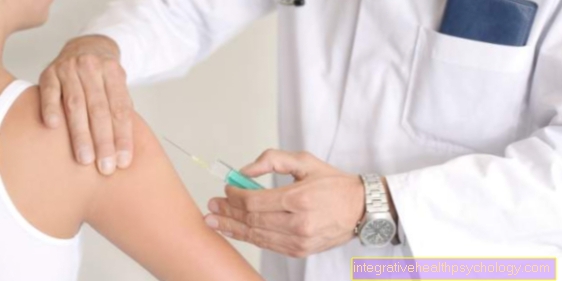
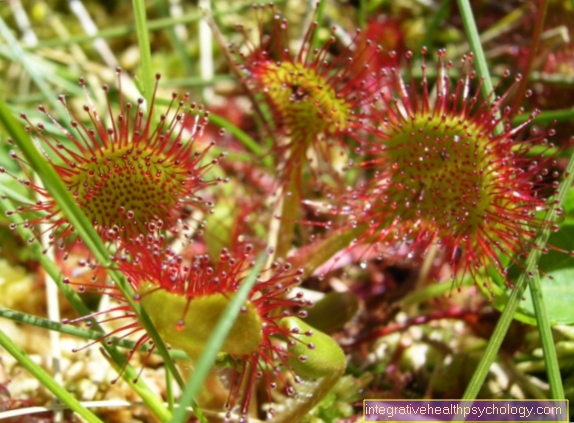
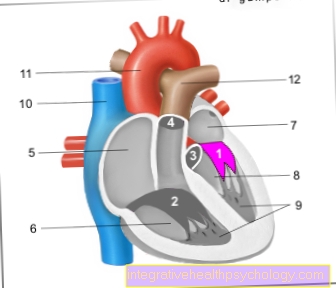
.jpg)



